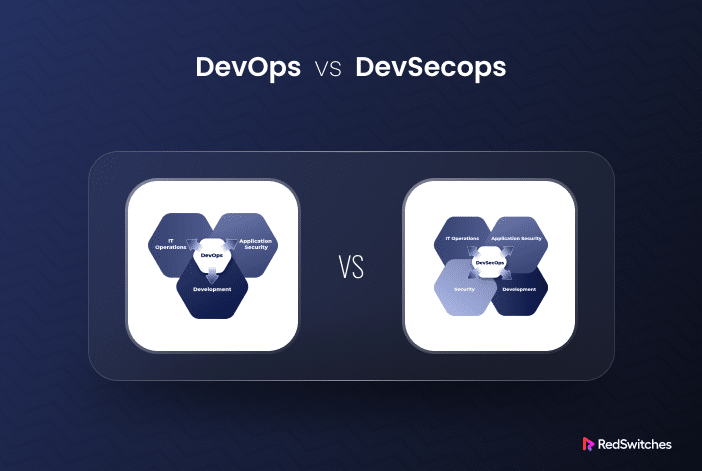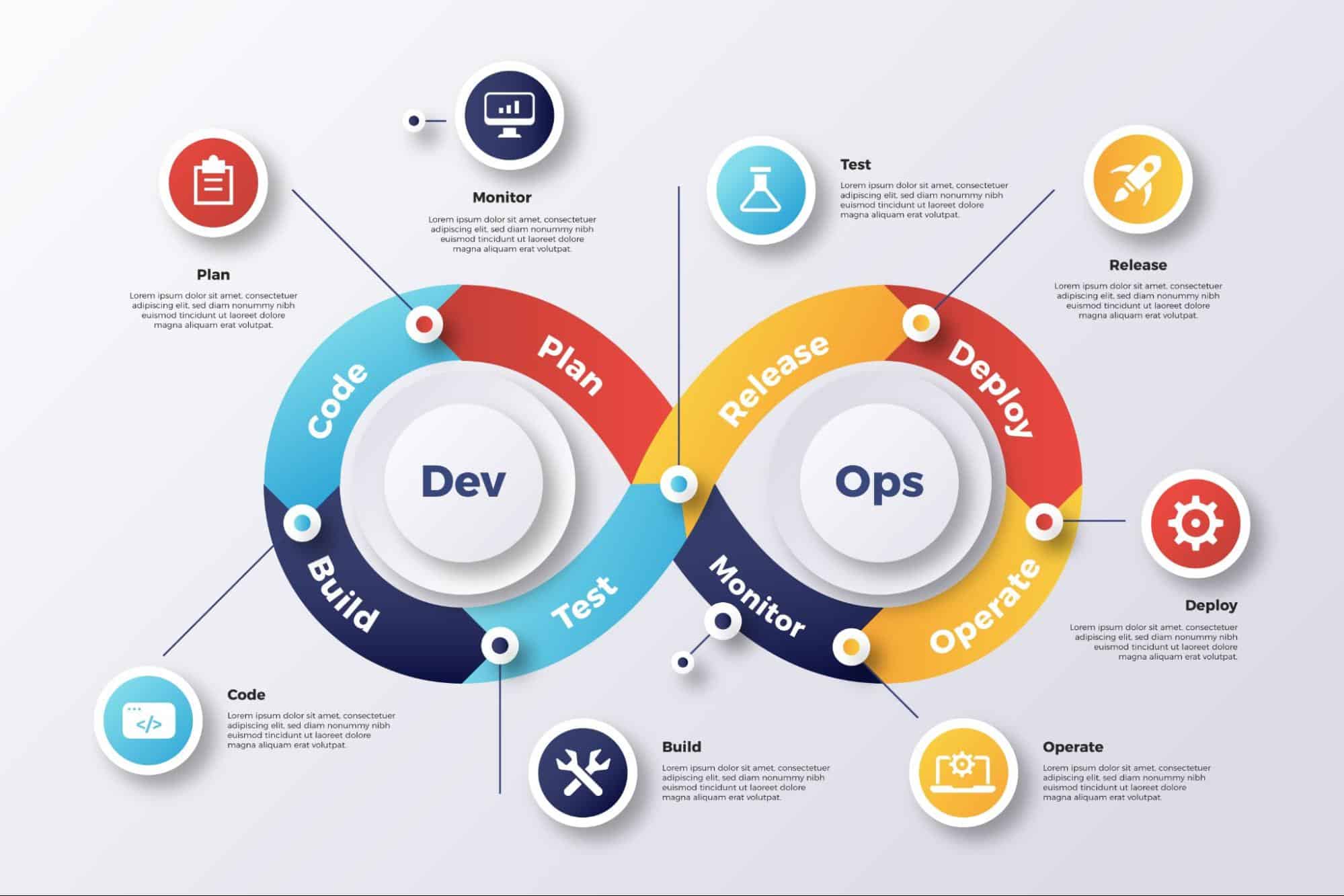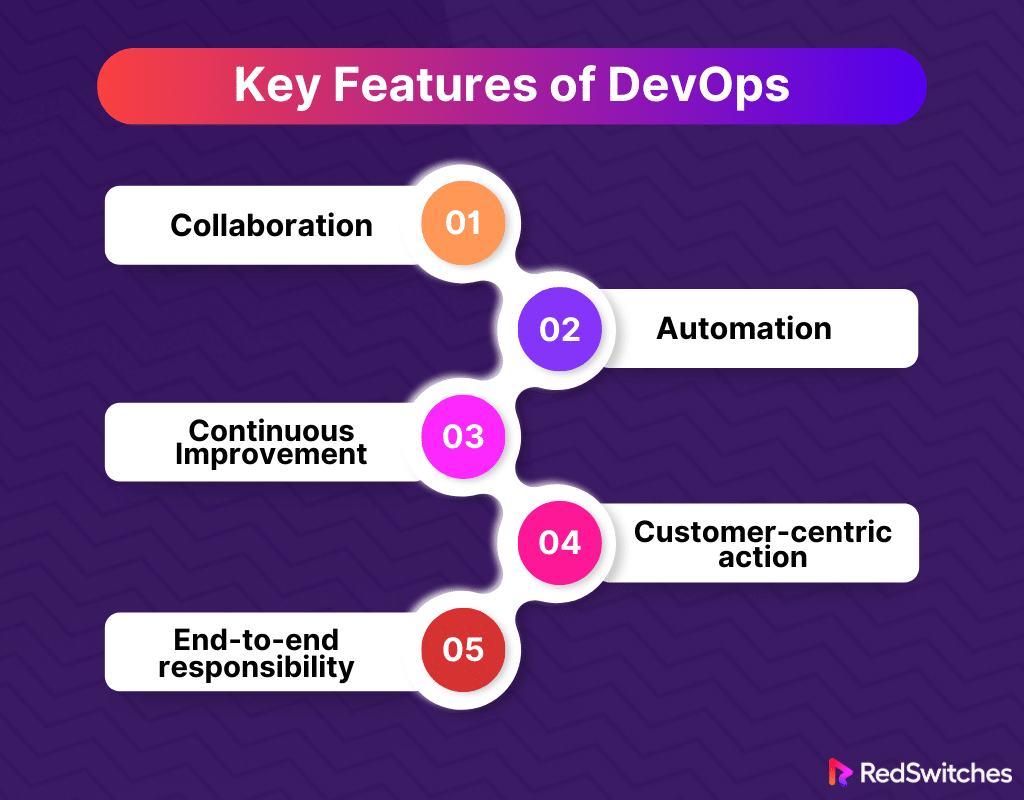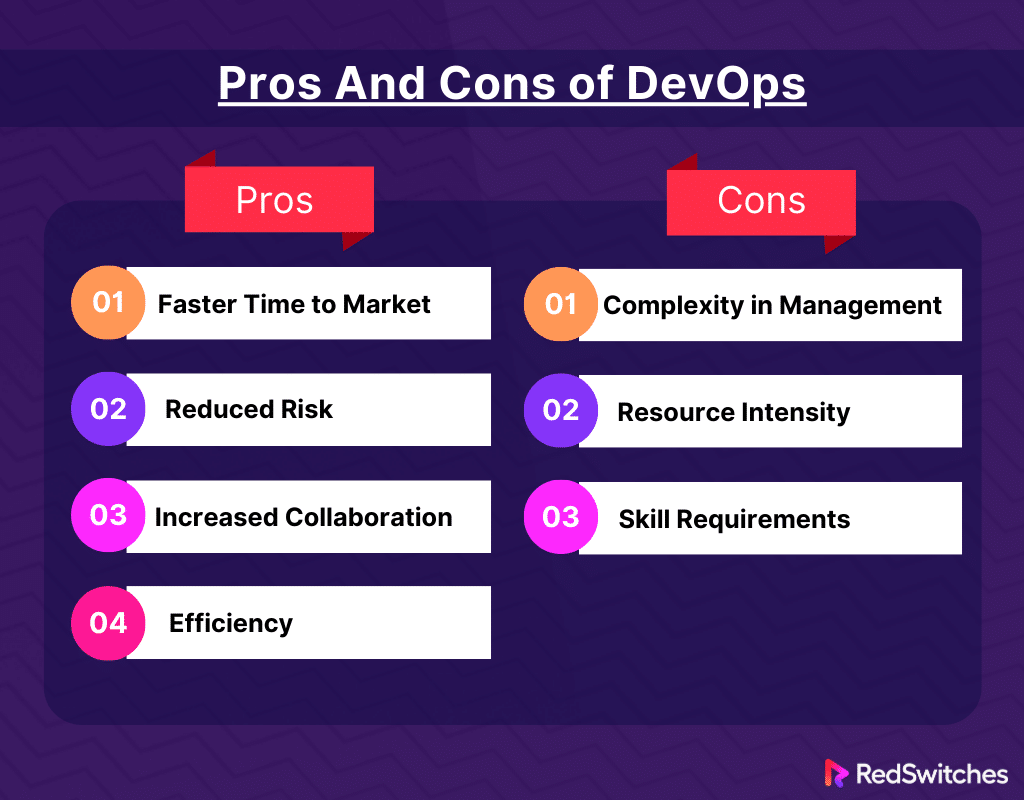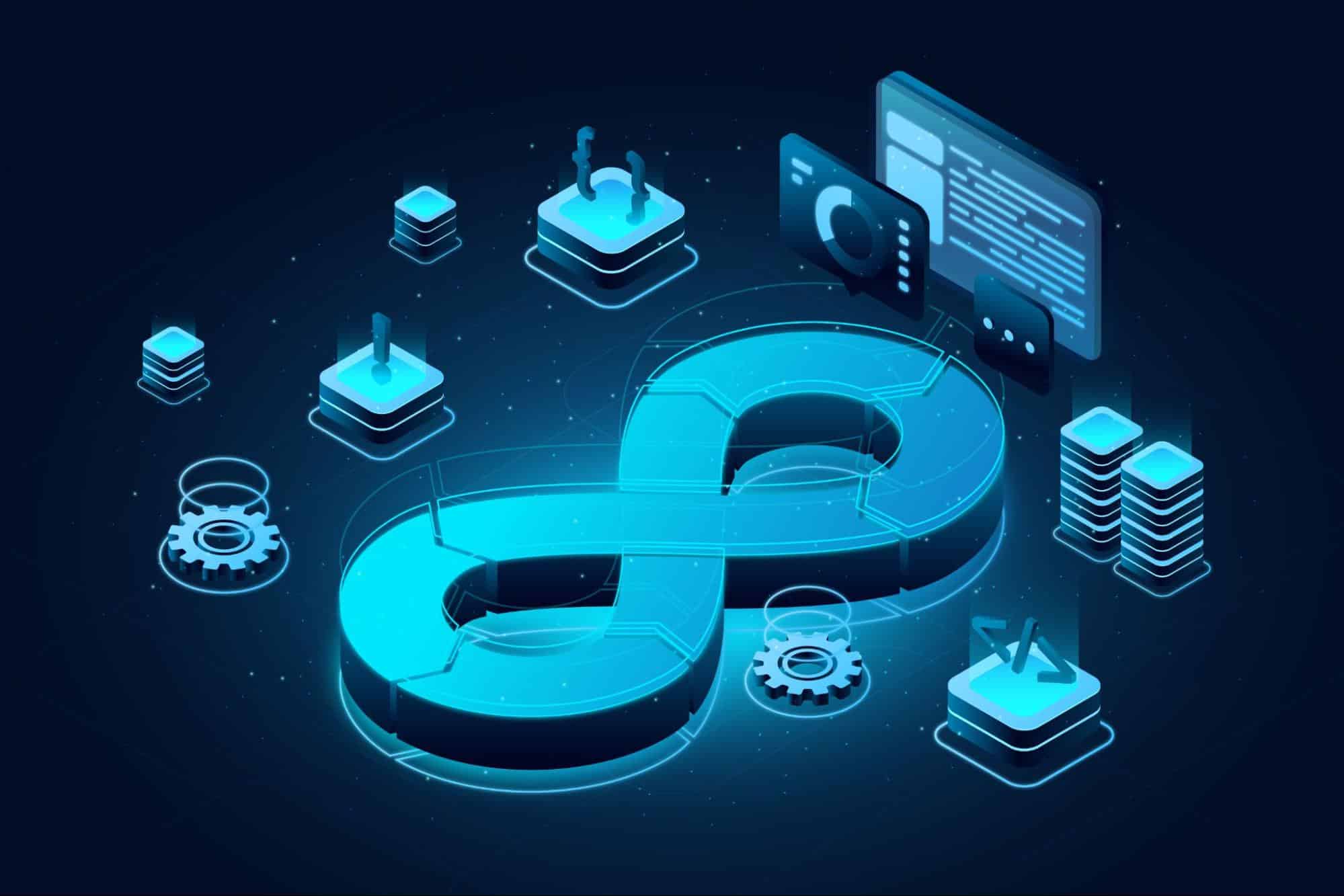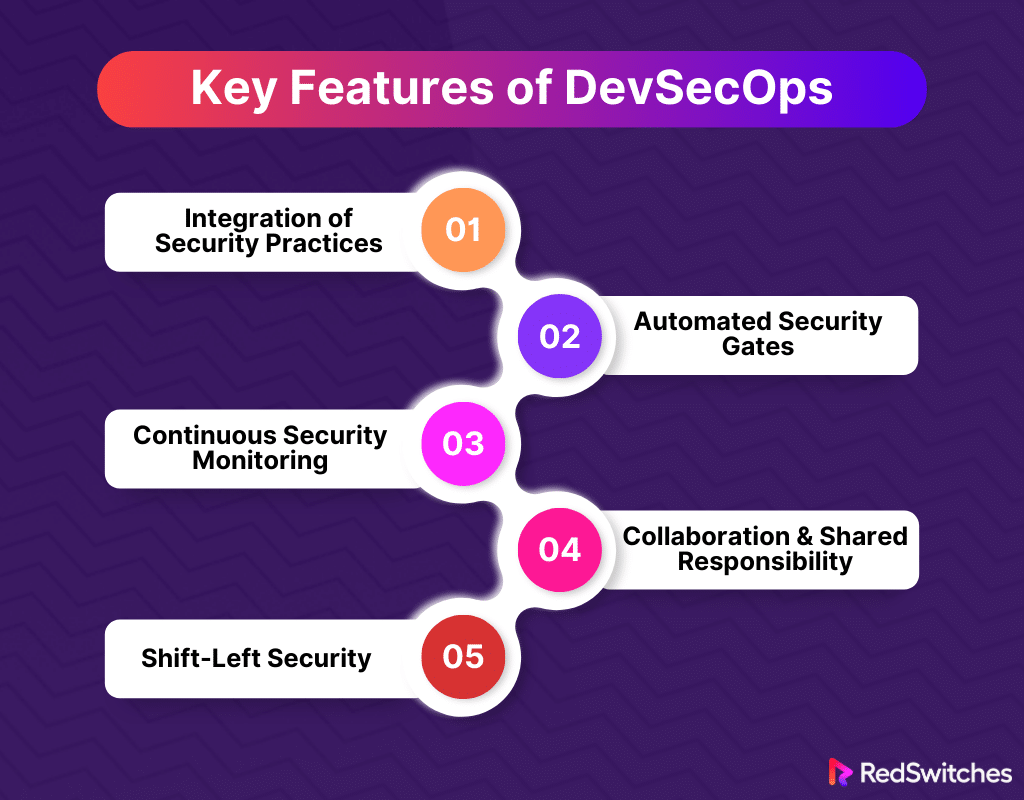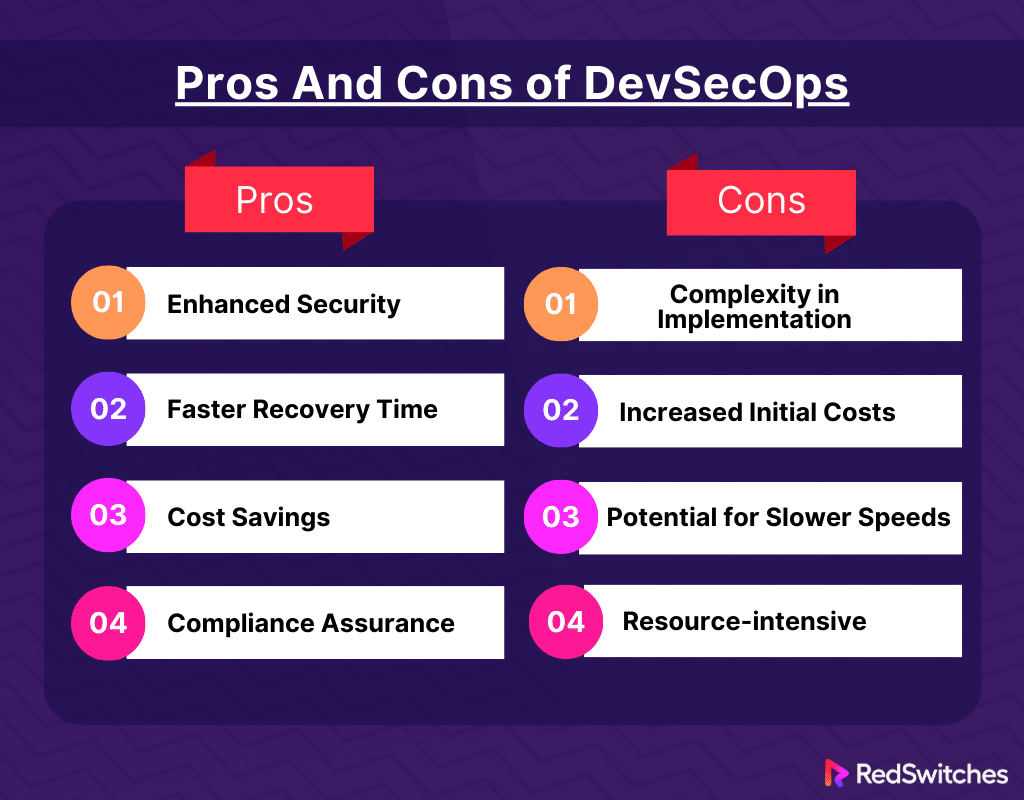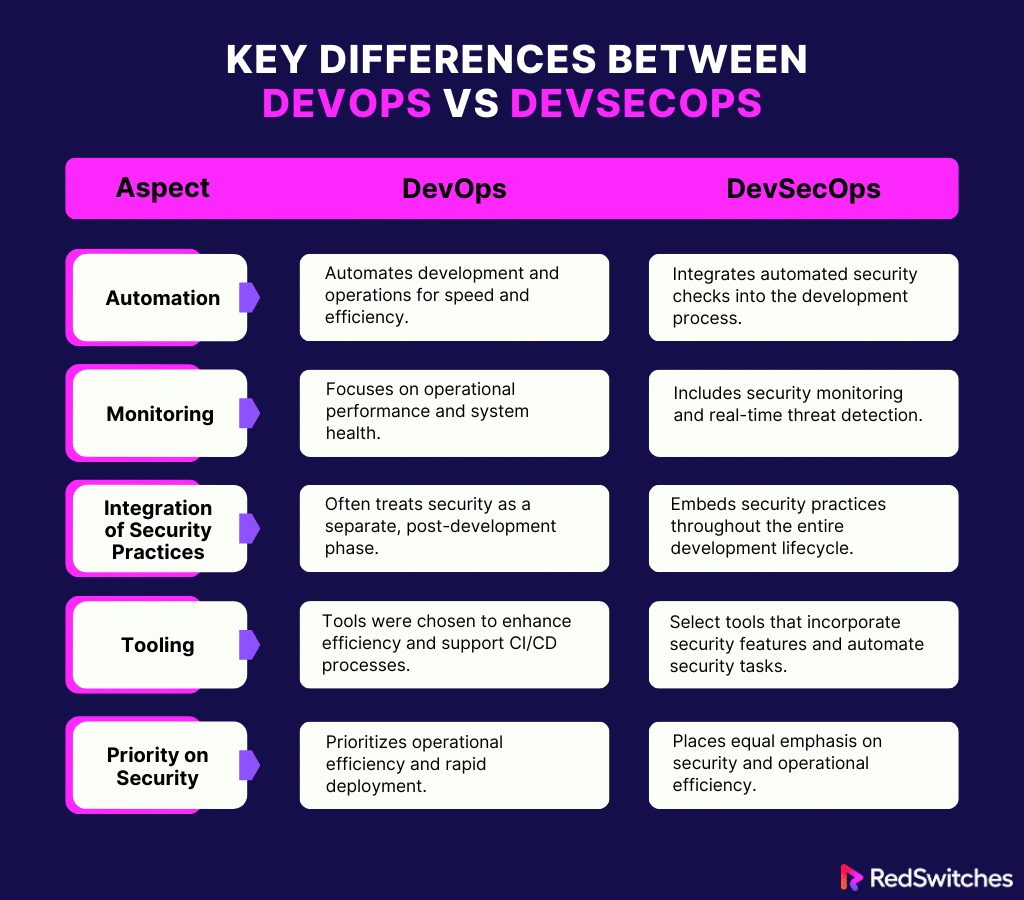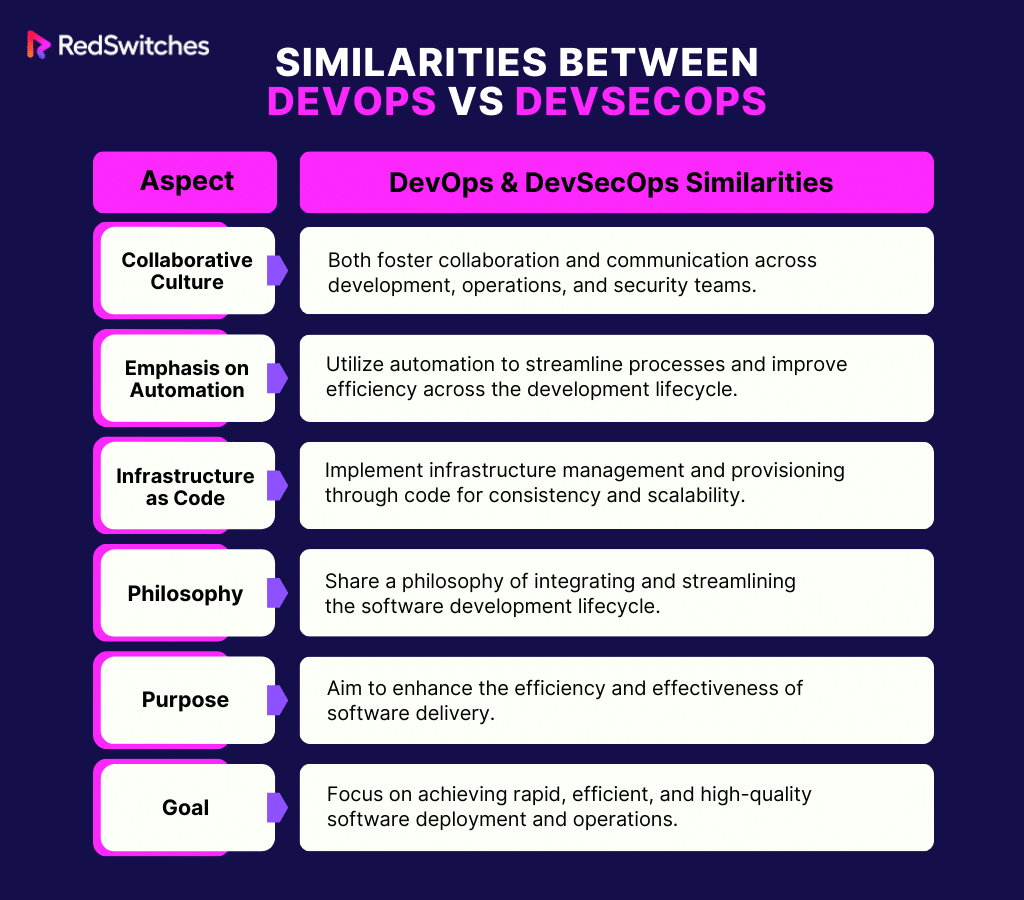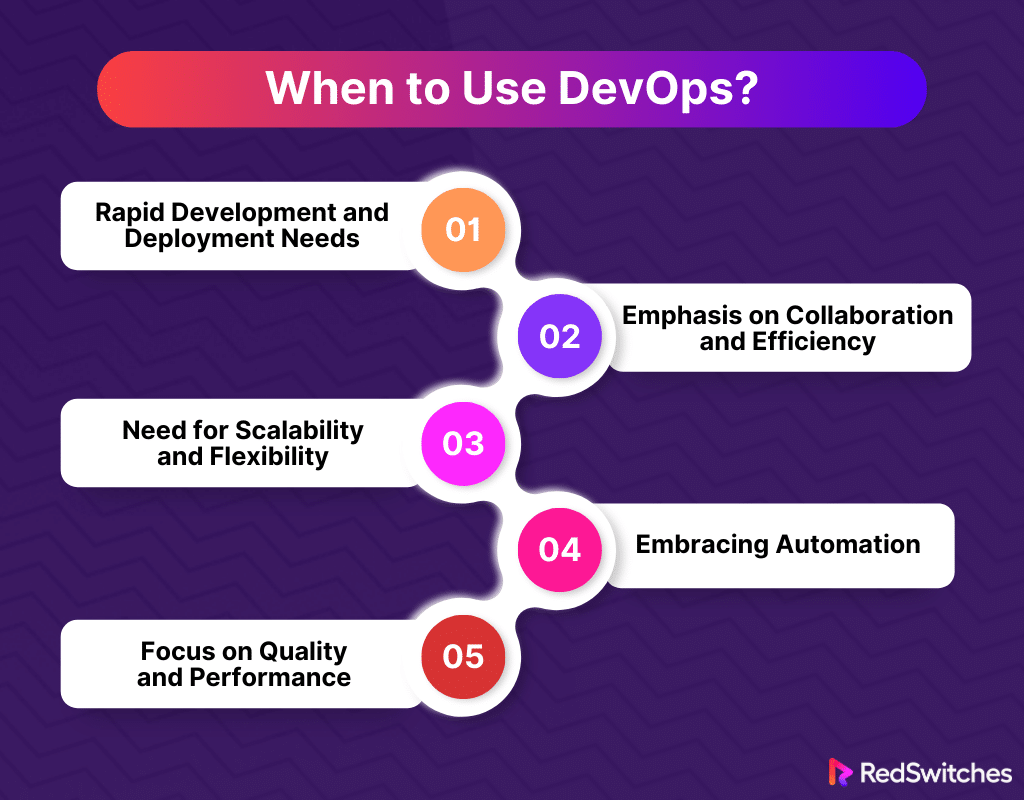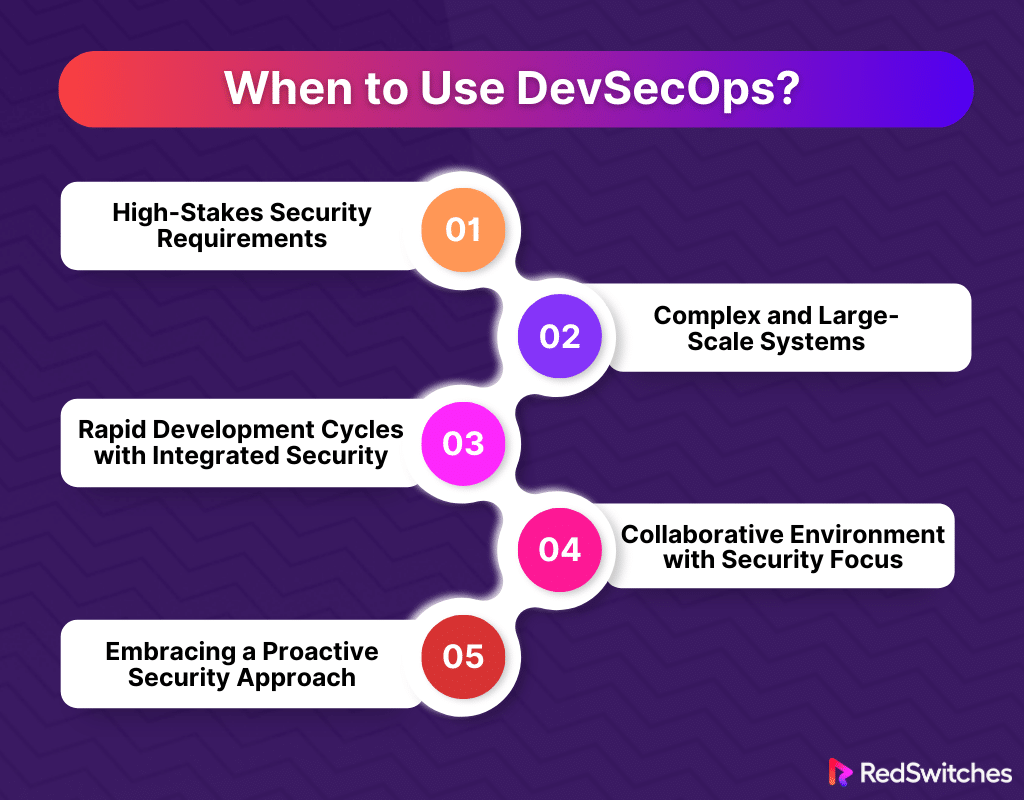DevOps and DevSecOps are two pivotal methodologies in software development that streamline and secure delivery processes. DevOps merges development with operations for swift, collaborative software creation, emphasizing efficiency and speed. DevSecOps builds on this by embedding security into every stage, ensuring it’s a proactive part of the life cycle rather than an add-on.
This article will clarify the distinctions and synergies between DevOps vs DevSecOps, helping you to determine which approach best suits your organization’s needs and security demands.
Join us as we integrate development, operations, and security into a unified IT strategy.
- What is DevOps?
- What is DevSecOps?
- DevOps vs DevSecOps Key Differences
- DevSecOps vs DevOps Similarities
- Transition from DevOps to DevSecOps
- When to Use DevOps?
- When to Use DevSecOps?
- Conclusion
- FAQs
What is DevOps?
DevOps is a transformative philosophy that merges software development (Dev) and IT operations (Ops), aimed at shortening the development life cycle and providing continuous delivery with high software quality. It’s not just a set of practices but a cultural shift that emphasizes team empowerment, collaboration, and technology automation to accelerate the delivery of applications and services at a higher velocity than traditional models.
Credits: Freepik
Key Features of DevOps
Here are the key features of DevOps, showcasing its innovative approach to agile collaboration and efficient software development:
- Collaboration: Teams work together from development through to operations, breaking down traditional silos and sharing responsibility for the product’s success.
- Automation: Much of the development, testing, and deployment processes are automated to increase efficiency, reduce errors, and allow more focus on new feature creation.
- Continuous Improvement: Constantly iterating to improve and optimize the development process, minimizing waste and speeding up delivery.
- Customer-centric Action: Using short feedback loops with customers to rapidly iterate on product development based on honest user feedback.
- End-to-end responsibility: Teams are involved in the product lifecycle from conception to deployment, ensuring a better understanding of the end-user and a higher-quality product.
Pros And Cons of DevOps
In this section of a detailed comparison of DevOps vs DevSecOps, we will discuss the pros and cons of DevOps, providing a balanced view of its benefits and challenges in modern software development.
Pros:
- Faster Time to Market: DevOps enables more frequent code releases, which means faster deployment of features and quicker response to market changes.
- Reduced Risk: Iterative cycles allow for frequent reassessment of product relevance and quality, reducing the risk of a product being outdated or flawed upon release.
- Increased Collaboration: Removing the barrier between development and operations enhances creativity and agility.
- Efficiency: Automated tools and the allowance for failure in small increments improve efficiency.
Cons:
- Complexity in Management: Integrating different processes and tools can introduce management challenges.
- Resource Intensity: The initial setup of DevOps practices requires significant investment in time and resources.
- Skill Requirements: DevOps demands a wide range of skills from the involved teams, which can be a hurdle for some organizations.
What is DevSecOps?
DevSecOps is an approach to culture, automation, and platform design that integrates security as a shared responsibility throughout the entire IT lifecycle. It’s an evolution of the DevOps methodology that emphasizes security, sometimes phrased as “Security as Code.”
Credits: Freepik
Key Features of DevSecOps
Here are the key features of DevSecOps, illustrating its comprehensive approach to integrating security into agile software processes.
- Integration of Security Practices: Security measures are integrated into the daily workflows of development, operations, and quality assurance teams.
- Automated Security Gates: Automation tools are employed to create security gates that check compliance and vulnerability issues before progression to the next stage of development.
- Continuous Security Monitoring: DevSecOps includes real-time security monitoring to identify and address vulnerabilities as they arise rather than at the end of the development cycle.
- Collaboration and Shared Responsibility: Security is considered a shared responsibility among team members, not just a concern for security officers.
- Shift-Left Security: Security checks and tests are performed earlier in the development process (shifted left) to catch issues sooner and reduce costs.
Pros and Cons of DevSecOps
Here are the pros and cons of DevSecOps, offering an insightful analysis of its strengths and considerations in secure software development.
Pros:
- Enhanced Security: By integrating security early in the development process, DevSecOps helps to prevent security issues before they arise.
- Faster Recovery Time: The DevSecOps approach allows for faster response and recovery when security issues occur.
- Cost Savings: Identifying and fixing security issues earlier is generally less expensive and time-consuming than addressing them after deployment.
- Compliance Assurance: Continuous compliance monitoring helps ensure the software meets regulatory standards throughout its lifecycle.
Cons:
- Complexity in Implementation: Integrating security into the DevOps process can be complex and requires a cultural shift within the organization.
- Increased Initial Costs: There may be higher initial costs due to the need for additional tools and training for staff.
- Potential for Slower Speeds: Although the aim is to integrate security without impacting speed, additional security checks can sometimes slow down the deployment process.
- Resource-intensive: It requires constant effort to maintain and update security measures and protocols, which can be resource-intensive.
DevSecOps represents a proactive stance on security, emphasizing that security is not just the responsibility of a single team but a foundational aspect of the entire software development and deployment process.
Also Read: What is Platform Engineering? Explore 12 IDP Tools
DevOps vs Devsecops Key Differences
Credits: Freepik
As the digital world advances at a breakneck pace, the methodologies we use to manage software development and deployment evolve to meet new challenges. Two such progressive methodologies are DevOps vs DevSecOps. While they share a foundational philosophy of integration and efficiency, they differ significantly in their approach to security.
This section will explore the key differences between DevOps and DevSecOps, dissecting how each framework addresses the critical intersection of development, operations, and security. Understanding these differences is not just about grasping new industry buzzwords—it’s about appreciating the nuances that can make or break the security and efficiency of software delivery in our increasingly interconnected ecosystem.
Join us as we delve into the distinguishing features that set DevOps vs DevSecOps apart and how they each contribute to the overarching goal of creating robust, reliable, and secure software products.
Automation
In modern software development, the distinction between DevOps vs DevSecOps particularly shines in automation. Both methodologies advocate for automation but apply it differently, reflecting their core priorities and objectives.
Automation in DevOps
- Focus on Speed and Efficiency: In DevOps, automation primarily aims to enhance the speed and efficiency of the software development process.
- Continuous Integration and Deployment (CI/CD): Automated pipelines for testing and deployment reduce manual intervention, leading to quicker release times.
- Automated Testing and Deployment: Processes like automated testing and build management ensure that software quality is maintained even as the development pace increases.
Automation in DevSecOps
- Integrating Security into Automation: The key distinction in DevSecOps is the integration of security measures directly into the automated processes.
- Automated Security Protocols: Security checks are embedded at every stage, from design to deployment, ensuring security is a priority.
- Early Detection of Security Issues: Automated security tools help identify and resolve vulnerabilities early on, making the entire development lifecycle more secure.
Key Differences
- Prioritization: While DevOps prioritizes rapid development and operations, DevSecOps places equal emphasis on security within this fast-paced environment.
- Security Integration: The significant difference between DevOps and DevSecOps is that the latter takes a proactive approach to security, making it an integral part of the automated processes.
- Response to Evolving Threats: DevSecOps addresses the need for robust security measures in response to the increasing complexity of cyber threats, which is a critical diff between DevOps and DevSecOps.
In summary, the DevOps vs DevSecOps comparison in terms of automation reveals a fundamental shift in how security is perceived and integrated.
Monitoring
While both DevOps vs Devsecops utilize monitoring to enhance their processes, DevSecOps emphasizes the security dimension, ensuring that monitoring efforts contribute to a more secure and resilient software development lifecycle.
Monitoring in DevOps
- Operational Performance Focus: In DevOps, monitoring is typically centered on operational performance and the health of applications.
- System Uptime and Performance Metrics: DevOps monitoring tools track system uptime, resource usage, and performance metrics.
- Feedback for Continuous Improvement: The collected data is used to continuously improve the development and deployment process.
Monitoring in DevSecOps
- Security-Centric Monitoring: DevSecOps extends monitoring to include security aspects, making it a more holistic approach.
- Real-Time Security Alerts: Security monitoring tools provide real-time alerts for security threats or vulnerabilities.
- Compliance and Vulnerability Tracking: Continuous monitoring of compliance with security policies and tracking vulnerabilities throughout the software lifecycle.
Key Differences
- Scope of Monitoring: The primary difference between DevOps and DevSecOps lies in the scope of monitoring. While DevOps focuses on operational aspects, DevSecOps incorporates security monitoring into the equation.
- Integration of Security Monitoring: A significant diff between DevOps and DevSecOps is how security is integrated into the monitoring strategy. DevSecOps treats security monitoring as an integral part of the process, not just an add-on.
- Proactive vs. Reactive Approaches: DevOps often takes a more reactive monitoring approach, focusing on system performance and stability. In contrast, DevSecOps adopts a proactive stance, prioritizing ongoing security threat detection and prevention.
In essence, the DevOps vs Devsecops comparison in terms of monitoring highlights the shift from a predominantly operational focus to a more integrated approach encompassing operational and security aspects.
Integration of Security Practices
In comparing DevOps vs DevSecOps, a fundamental aspect is the integration of security practices. This integration is a defining characteristic that differentiates the two methodologies, reshaping how security is approached throughout the development lifecycle.
Security Integration in DevOps
- Security as a Subsequent Phase: Security is often a separate, subsequent phase within DevOps. Post-development security checks are standard, where security assessments occur after major development stages, sometimes leading to delays if significant security issues are discovered late in the process.
Security Integration in DevSecOps
- Ingrained Security from the Start: Unlike DevOps, DevSecOps ingrains security practices from the beginning of the development process. Security considerations are integrated into each stage, from design to deployment, ensuring continuous attention to security risks.
- Proactive Security Measures: This approach allows for proactively identifying and mitigating security risks rather than reacting post-development.
- Continuous Security Feedback: Ongoing security feedback is integrated into the development cycle, enabling real-time adjustments and improved security posture.
Key Differences
- The Timing of Security Integration: The main difference between DevOps and DevSecOps is when and how security is integrated. While DevOps might treat security as an end-stage check, DevSecOps embeds it throughout the process.
- Approach to Security Risks: The diff between DevOps and DevSecOps is also evident in their approach to security risks—DevOps may be more reactive, whereas DevSecOps is inherently proactive.
In summary, the DevOps vs DevSecOps debate centralizes around integrating security practices. DevOps separates development and security, potentially leading to later-stage security challenges.
Credits: Unsplash
Tooling
In understanding what is the difference between DevOps vs DevSecOps, one key area to explore is tooling. The choice and implementation of tools within these frameworks significantly influence their effectiveness and outcomes.
Tooling in DevOps
- Focus on Efficiency and Speed: In DevOps, tooling is primarily selected to enhance efficiency and accelerate development and deployment.
- CI/CD Tools: Continuous Integration and Continuous Deployment tools are central, facilitating quick code integration and deployment.
- Collaboration and Monitoring Tools: Tools supporting team collaboration and monitoring real-time operations are also crucial.
Tooling in DevSecOps
- Security-Centric Tool Selection: With DevSecOps, the tooling extends beyond efficiency and includes security-focused tools.
- Integrated Security Tools: Tools in DevSecOps are chosen for their ability to integrate security into the CI/CD pipeline, such as automated security testing and vulnerability scanning.
- Real-Time Security Monitoring: Tools for continuous security monitoring and compliance checks are integral, providing ongoing visibility into security posture.
Key Differences
- Purpose of Tools: The main difference between DevOps vs DevSecOps lies in the purpose and functionality of the tools used. DevOps tools are selected for speed and efficiency, while DevSecOps tools are chosen for their ability to embed security into these processes.
- Integration of Security Features: In DevOps, security might be an add-on feature in tooling, but in DevSecOps, security features are a fundamental aspect of the toolset.
In essence, when considering DevOps, DevSecOps, and what is the difference between devops and devsecops, the tooling aspect reveals a clear divergence. While DevOps focuses on tools that facilitate rapid development and deployment, DevSecOps prioritizes tools that integrate security seamlessly into these processes, reflecting their respective core priorities and methodologies.
Also Read: Agile vs DevOps: Which Is The Best Tool For 2024?
Priority on Security
When exploring the DevOps vs DevSecOps landscape, a critical aspect to consider is the priority placed on security within each framework. This focus on security sets these two methodologies apart, influencing how teams approach, manage, and integrate security measures in their workflows.
Security in DevOps
- Security as a Distinct Phase: In DevOps, security is often treated as a separate, distinct phase in the development cycle. It’s typically addressed post-development or as a final check before deployment.
- Reactive Security Measures: The approach to security in DevOps can be more reactive, with security issues often being addressed after they are identified in the development or deployment stages.
Security in DevSecOps
- Security as a Continuous Process: DevSecOps embeds security as a continuous process throughout the software development lifecycle.
- Proactive and Integrated Security Approach: Security is integrated from the outset, with proactive measures implemented to identify and mitigate risks early in development.
- Shared Security Responsibility: There’s a culture of shared responsibility for security involving all team members, not just dedicated security professionals.
Key Differences
- Integration and Timing: The primary difference between DevOps vs DevSecOps regarding security is in its integration and timing. DevSecOps integrates security from the beginning, whereas DevOps often treats it as a later-stage addition.
- Proactive vs Reactive: DevSecOps promotes a proactive approach to security, continuously integrating it throughout the development process, while DevOps tends to be more reactive, dealing with security after the primary development stages.
In summary, the distinction between DevOps vs DevSecOps concerning security is profound. DevSecOps places a heightened, proactive emphasis on security throughout the entire development cycle, while DevOps often views security as a separate, possibly final phase in the process.
Also Read: Understanding the Puppet Architecture: Master, Agent, and Resources
Here’s a concise table outlining the key differences between DevOps vs DevSecOps:
DevSecOps vs DevOps Similarities
Credits: Freepik
In the evolving software development landscape, DevOps vs DevSecOps, while distinct in their approaches, share a foundational core of principles and practices. This section, “DevSecOps vs DevOps Similarities,” highlights the common ground between these two methodologies. From fostering a collaborative culture to embracing automation and agile practices, understanding these similarities provides valuable insights into how both frameworks aim to enhance the efficiency and effectiveness of software development in today’s fast-paced technological world.
Collaborative Culture
In examining DevSecOps vs DevOps, it’s evident that both methodologies foster a culture of collaboration, albeit with different focal points. This shared emphasis on teamwork and shared responsibility is a cornerstone in both approaches, shaping how teams interact and work towards common goals.
Collaborative Culture in DevOps
- Cross-Functional Teams: DevOps encourages the breaking down of silos between development and operations teams.
- Shared Goals and Processes: There’s a strong focus on shared objectives, where developers and operations staff work together through the entire software development lifecycle.
- Communication and Feedback Loops: Open communication channels and continuous feedback loops are integral, ensuring all team members are aligned and informed.
Collaborative Culture in DevSecOps
- Extended Collaboration to Include Security: DevSecOps extends the collaborative ethos of DevOps by integrating security teams into the mix.
- Security as a Shared Responsibility: It promotes the idea that security is everyone’s responsibility, not just that of the security team.
- Enhanced Communication Across All Teams: This approach necessitates enhanced communication and collaboration between development, operations, and security teams.
Key Similarities
- Team Integration and Communication: A primary similarity in DevSecOps vs DevOps is the emphasis on integrating various teams and fostering open communication. In both methodologies, breaking down traditional silos is crucial.
- Shared Responsibility and Goals: DevSecOps and DevOps advocate for a culture where all team members share responsibility for the project’s success. This shared responsibility extends across development, operations, and, in the case of DevSecOps, security.
In conclusion, the collaborative culture is a fundamental similarity in DevOps vs DevSecOps. While DevOps focuses on integrating development and operations, DevSecOps adds security into the collaborative mix.
Credits: Freepik
Emphasis on Automation
In examining DevSecOps vs DevOps, it’s evident that both methodologies strongly emphasize automation, albeit with different focal points. This shared commitment to automating processes is a cornerstone in both approaches, shaping how teams interact and work towards common goals.
Emphasis on Automation in DevOps
- Streamlining Development and Operations: DevOps encourages automating tasks across the development and operations spectrum, aiming to enhance efficiency and speed.
- CI/CD Pipelines: Central to DevOps, these pipelines automate the integration and deployment of code, reducing manual intervention and accelerating delivery.
Emphasis on Automation in DevSecOps
- Integrating Security into Automation: DevSecOps extends the automation ethos of DevOps by incorporating security checks and protocols within the automated processes.
- Automated Security Testing: DevSecOps strongly emphasizes automating security testing and compliance monitoring in addition to traditional DevOps automation.
Key Similarities
- Reducing Manual Efforts: A primary similarity in DevOps vs DevSecOps is using automation to reduce manual efforts, thereby minimizing errors and increasing efficiency.
- Enhancing Process Efficiency: Both methodologies aim to enhance process efficiency through automation — DevOps focuses on development and operations, while DevSecOps integrates security into this automated pipeline.
In conclusion, the emphasis on automation is a fundamental similarity in DevOps vs DevSecOps. While DevOps focuses on automating the development and operations aspects, DevSecOps adds security into the automated mix, ensuring that rapid development cycles are secure and compliant.
Infrastructure as Code
In both DevSecOps and DevOps, the concept of “Infrastructure as Code” (IaC) plays a pivotal role. IaC is a crucial practice where infrastructure is provisioned and managed using code and software development techniques rather than manual processes. This approach is fundamental in both methodologies for automating and streamlining the deployment and management of infrastructure.
Infrastructure as Code in DevOps
- Automated Environment Provisioning: DevOps uses IaC to automate the setup and management of environments, from development to production.
- Consistency and Efficiency: IaC in DevOps ensures consistency across environments and improves efficiency by reducing manual setup and configuration errors.
- Rapid Deployment and Scaling: It enables teams to deploy and scale infrastructure in response to application needs quickly.
Infrastructure as Code in DevSecOps
- Security Integration in Infrastructure: DevSecOps extends the concept of IaC by integrating security aspects into the code that manages infrastructure.
- Automated Security Compliance: IaC in DevSecOps involves scripting security configurations and compliance policies, ensuring that security is consistently applied across all environments.
- Proactive Security Measures: DevSecOps enables proactive identification and mitigation of infrastructure-related security risks by codifying security measures.
Key Similarities
- Use of Code to Manage Infrastructure: A fundamental similarity in DevSecOps vs DevOps is the use of code to automate the provisioning and management of infrastructure.
- Improving Consistency and Reducing Errors: Both methodologies leverage IaC to achieve consistency across environments and to reduce the potential for manual errors.
- Facilitating Rapid Changes: IaC allows for rapid infrastructure changes in DevOps and DevSecOps, aligning with the agile nature of modern software development.
In essence, “Infrastructure as Code” is a shared practice in DevSecOps vs DevOps that significantly contributes to IT infrastructure’s efficiency, consistency, and scalability. While DevOps focuses on the speed and efficiency of infrastructure management, DevSecOps incorporates an additional layer of security, ensuring that it remains secure and compliant as the infrastructure is rapidly deployed and scaled.
Credits: Freepik
Philosophy
The philosophies guiding DevSecOps and DevOps provide the foundational principles for these methodologies, shaping how organizations approach software development, operations, and security.
Philosophy of DevOps
- Collaboration and Integration: At its core, DevOps is about breaking down silos between development and operations teams. It fosters a culture of collaboration and shared responsibility.
- Agility and Speed: DevOps emphasizes agility and speed in software delivery, focusing on continuous improvement and responsiveness to change.
- Automating Processes: A significant aspect of DevOps philosophy is the emphasis on automating as many processes as possible to improve efficiency and reduce manual errors.
Philosophy of DevSecOps
- Security as a Shared Responsibility: DevSecOps extends the DevOps philosophy by embedding security into every stage of the software development lifecycle. Security is not an afterthought but an integral part of the process.
- Proactive Security Measures: The philosophy here is proactive rather than reactive security measures, addressing security issues at the outset rather than after a breach or failure.
- Continuous Security and Compliance: Continuous security practices and compliance monitoring are fundamental, ensuring security keeps pace with rapid development cycles.
Key Similarities
- Emphasis on Collaboration: DevSecOps and DevOps promote a culture of collaboration, where cross-functional teams work closely together.
- Focus on Continuous Improvement: The philosophies of both methodologies prioritize continuous improvement, be it in terms of efficiency, speed, or security.
- Agile Approach: DevSecOps and DevOps share an agile approach to software development, accommodating rapid changes and fostering an environment of ongoing adaptation and growth.
In summary, the overarching philosophies of DevOps vs DevSecOps share several key principles, such as collaboration, continuous improvement, and an agile approach. The primary distinction lies in how each methodology integrates and prioritizes security, with DevSecOps emphasizing security as an intrinsic part of the development and deployment process.
Understanding the purpose of DevOps and DevSecOps is key to recognizing how each methodology fits within the broader context of software development and IT operations:
Purpose of DevOps
- Enhance Collaboration: DevOps aims to bridge the gap between development and operations teams, fostering a culture of collaboration and shared responsibility.
- Speed and Efficiency: The primary purpose of DevOps is to speed up the development process, ensuring quick deployment and operational efficiency.
- Continuous Improvement: DevOps is designed to promote a cycle of continuous development, testing, deployment, and feedback, facilitating ongoing improvement.
Purpose of DevSecOps
- Integrate Security: DevSecOps extends the principles of DevOps by embedding security into every stage of the software development lifecycle.
- Balanced Speed and Security: While maintaining the efficiency and speed of DevOps, DevSecOps places equal emphasis on ensuring security and compliance throughout the process.
- Proactive Risk Management: DevSecOps aims to adopt a proactive approach to security, identifying and addressing potential threats early in the development process.
Key Similarities
- Efficient and Effective Software Delivery: DevOps and DevSecOps share the purpose of delivering software efficiently and effectively, aligning closely with business objectives and market demands.
- Adaptability and Responsiveness: They aim to create adaptable and responsive IT environments that can quickly respond to changes, whether related to market trends, customer feedback, or security threats.
While debating DevOps vs DevSecOps, both have distinct focuses; their overarching purpose converges on enhancing the software development lifecycle — DevOps through speed and efficiency and DevSecOps through the integration of security into this efficient process.
Goal
The ultimate goals of DevSecOps and DevOps, while closely aligned, highlight the nuanced differences in how each methodology approaches software development and deployment.
Goal of DevOps
- Efficient and Rapid Delivery: The primary goal of DevOps is to improve the efficiency and speed of software delivery. It aims to shorten the system development life cycle while delivering features, fixes, and updates frequently in close alignment with business objectives.
- Enhancing Collaboration: Another key goal is to foster a culture where development, QA, and operations teams collaborate closely, breaking down traditional silos to improve overall productivity and efficiency.
- Continuous Integration and Deployment: DevOps emphasizes the importance of continuous integration and deployment to ensure quick and reliable software release cycles.
Goal of DevSecOps
- Integrating Security into DevOps: The fundamental goal of DevSecOps is to integrate security practices seamlessly into the DevOps process. It shifts the traditional approach of applying security at the end of the development process to a more integrated approach throughout the entire lifecycle.
- Proactive Risk Management: By embedding security from the start, DevSecOps aims to proactively identify and mitigate risks rather than reacting to security incidents after they occur.
- Maintaining Speed Without Sacrificing Security: While aligning with DevOps’s speed and efficiency goals, DevSecOps also ensures that these are not achieved at the cost of security. It balances rapid development with robust security measures.
Key Differences
- Focus and Integration of Security: The main difference in the DevOps vs DevSecOps goals lies in the integration and focus on security. DevSecOps emphasizes rapid delivery and security, while DevOps focuses more on efficiency and speed.
- Approach to Risk Management: DevSecOps proactively manages risks throughout the development process, whereas DevOps tends to focus more on post-development risk management and mitigation.
In conclusion, the goals of DevSecOps and DevOps reflect their respective focuses and methodologies. While both aim to enhance the efficiency and effectiveness of software development and deployment, DevSecOps incorporates a strong and proactive security focus, ensuring that rapid development cycles do not compromise the security and integrity of the software.
Here’s a concise table highlighting the similarities between DevOps and DevSecOps:
Also Read: What is PaaS? Platform-as-a-Service Types Explained
Transition from DevOps to DevSecOps
Transitioning from DevOps to DevSecOps is a vital step for organizations aiming to integrate security deeply and seamlessly into their software development lifecycle. This shift isn’t just about adopting new tools; it’s about evolving the organizational culture and practices to prioritize security at every stage.
Understanding the Need for Transition
- Recognizing Security Evolution: Acknowledge that security is a dynamic and integral part of app development, not an isolated aspect.
- Aligning Security with Agile Practices: Embrace the concept that security needs to be as agile and integrated as the DevOps process itself.
Implementing a Structured Approach
- Programmatic Learning: Adopt a programmatic approach to update tooling, governance processes, and training, ensuring continuous learning and adaptation.
- Customized Security Framework: Develop a DevSecOps-specific security framework to govern tasks across the CI/CD pipeline. This framework should include KPIs and risk thresholds tailored to different applications, providing clarity and consistency.
Cultural Transformation
- Fostering a Security-First Mindset: Encourage a cultural shift where security is everyone’s responsibility, not just the security team’s.
- Promoting Security Champions: Identify and nurture ‘security champions’ within teams to advocate for and guide security practices.
Establishing a DevSecOps Center of Excellence
- Building a Cross-Functional Team: Create a center of excellence with a focus on researching, developing best practices, and automating manual tasks, extending existing DevOps frameworks to include security.
- Standardization and Tool Optimization: Develop templates for security tasks and fine-tune tools to reduce false positives, ensuring consistency across the organization.
Integrating and Automating Security Governance
- Embracing ‘Shift Left’ Practices: Move security testing earlier in the development lifecycle to improve quality and security.
- Automating Governance: Implement systems to track and automate governance, aligning tools with predefined metrics and thresholds.
Starting the DevSecOps Journey
- Conduct a Security Review: Begin with a thorough review of your current security posture to DevOps practices.
- Setting Goals and Metrics: Define clear objectives for the transition to DevSecOps, including specific tasks, cultural change strategies, and KPIs to monitor progress.
Adding Unique Strategies
- Incremental Implementation: Start integrating security practices in smaller, manageable segments of your DevOps process to allow gradual adaptation.
- Continuous Feedback and Improvement: Establish a feedback loop from all stakeholders to refine and improve the security integration process continuously.
- Resource Allocation for Security Education: Invest in training and resources to upskill teams in security best practices and tools relevant to DevSecOps.
The transition from DevOps to DevSecOps is an evolving journey beyond process changes, encapsulating a broader organizational transformation towards a security-centric development culture. By methodically integrating security at every stage, organizations can ensure that their software delivery is efficient and robustly secure.
When to Use DevOps?
When to implement DevOps in your organization depends on various factors, including your project requirements, organizational culture, and business goals. Here’s a guide to understanding the ideal scenarios for employing DevOps:
Rapid Development and Deployment Needs
- Frequent Updates: Opt for DevOps if your project requires regular updates and quick feature releases.
- Fast-Paced Markets: DevOps facilitates quick responses to these changes in industries where market demands change rapidly.
Emphasis on Collaboration and Efficiency
- Breaking Down Silos: DevOps is ideal when you aim to eliminate the barriers between development and operations teams.
- Enhanced Team Collaboration: Choose DevOps if your goal is to foster a culture of collaboration and continuous feedback among cross-functional teams.
Need for Scalability and Flexibility
- Scalable Infrastructure: DevOps supports scalable and flexible infrastructure management, which is especially beneficial for cloud-based environments.
- Adaptable to Changing Requirements: DevOps offers the agility to adapt quickly if your projects require frequent adjustments.
Embracing Automation
- Automating Routine Tasks: DevOps is suitable when you want to automate tasks like testing, deployment, and environment setup, thereby improving efficiency and reducing manual errors.
- Continuous Integration and Continuous Deployment: Projects that benefit from CI/CD pipelines, where code is frequently integrated and deployed, are ideal for DevOps.
Focus on Quality and Performance
- Continuous Testing: DevOps integrates continuous testing in the development process, ensuring early detection of issues and maintaining quality.
- Performance Monitoring: Continuous application performance monitoring is a key aspect of DevOps, making it suitable for systems requiring high uptime and performance.
When Not to Use DevOps?
- Low Complexity Projects: The transition to DevOps might not be cost-effective for simple, low-complexity projects with infrequent changes.
- Organizations Resistant to Cultural Change: If an organization has a rigid structure resistant to the cultural shift towards collaboration and rapid iteration, implementing DevOps can be challenging.
In conclusion, DevOps is most beneficial for dynamic projects requiring rapid development, high collaboration, and continuous delivery. It’s suited for organizations willing to embrace a cultural transformation towards a more integrated and agile approach to software development. However, weighing the nature of your projects and organizational readiness is essential before adopting DevOps practices.
When to Use DevSecOps?
Adopting DevSecOps is a strategic decision that hinges on specific organizational needs, especially regarding security integration in the development process. Here’s a guide to understanding when implementing DevSecOps is most beneficial:
High-Stakes Security Requirements
- Sensitive Data Handling: Opt for DevSecOps if your project involves handling sensitive data, such as financial, healthcare, or personal user data, where security breaches could have significant repercussions.
- Regulatory Compliance: If your software must comply with stringent regulatory standards (like GDPR, HIPAA), DevSecOps ensures continuous adherence to these regulations throughout development.
Complex and Large-Scale Systems
- Large-scale Infrastructure: For organizations managing large-scale or complex infrastructures, especially in cloud environments, DevSecOps provides a framework to maintain security at scale.
- Microservices Architecture: Projects utilizing microservices benefit from DevSecOps, as it helps manage the increased security complexity inherent in such architectures.
Rapid Development Cycles with Integrated Security
- Continuous Deployment and Updates: If your project demands frequent updates and rapid deployment without compromising on security, DevSecOps is ideal.
- Early Security Integration: Projects that can benefit from integrating security practices right from the design phase should adopt DevSecOps.
Collaborative Environment with Security Focus
- Shared Security Responsibility: DevSecOps is suitable for cultures promoting shared responsibility for security across all team members, not just a dedicated security team.
- Enhanced Team Collaboration: Choose DevSecOps to foster close collaboration between development, operations, and security teams.
Embracing a Proactive Security Approach
- Proactive Risk Management: DevSecOps is ideal for projects where proactive risk management is crucial, allowing teams to address security issues before they escalate.
- Automated Security Checks: Projects leveraging automated security testing and monitoring throughout the development lifecycle are well-suited for DevSecOps.
When Not to Use DevSecOps?
- Lower Risk Projects: For projects with lower security risks or less complex infrastructure, extensive security integration in DevSecOps might not be necessary.
- Organizations with Limited Security Resources: If an organization lacks the resources or expertise to implement and manage continuous security practices, adopting DevSecOps can be challenging.
In summary, DevSecOps is highly recommended for projects with significant security considerations and compliance requirements and where security breach costs are high. It’s best suited for environments ready to integrate security as a core aspect of the development lifecycle and willing to invest in the necessary resources and cultural changes. However, a full-fledged DevSecOps approach might not be as critical for more straightforward projects with lower security risks.
Conclusion
In the dynamic landscape of software development, DevOps vs DevSecOps stand as pivotal methodologies, each with unique strengths and focus areas. While DevOps centers on enhancing the efficiency and speed of software delivery through collaboration and automation, DevSecOps extends these principles by integrating security at every stage of the development lifecycle.
DevOps is ideal for projects requiring rapid development and deployment, emphasizing agility and operational efficiency. It suits organizations looking to break down silos between development and operations teams, fostering a culture of continuous improvement and collaboration.
DevSecOps, on the other hand, is crucial for projects where security is paramount. It is particularly suited for handling sensitive data, complying with stringent regulatory standards, and managing complex infrastructures. By embedding security practices from the outset, DevSecOps ensures that rapid development cycles do not compromise the security and integrity of the software.
Both methodologies are not mutually exclusive but represent a continuum of practices that organizations can adapt based on their specific needs, project requirements, and security priorities. The nature of your project, your organizational culture, and the level of security integration required should guide the decision to choose between DevOps and DevSecOps.
Are you navigating the crossroads of DevOps and DevSecOps for your organization? Let RedSwitches be your guide in this journey. With our expertise in both methodologies, we can help you streamline your software development process, integrate essential security practices, and ensure your infrastructure is agile and secure. Connect with us at RedSwitches to explore how we can tailor these methodologies to fit your unique needs, ensuring a seamless, efficient, and secure software development lifecycle. Contact RedSwitches today to start your journey towards a more efficient and secure software development process with their best dedicated servers.
FAQs
Q. Does DevSecOps replace DevOps?
No, DevSecOps does not replace DevOps. It evolves and enriches DevOps by integrating security into the existing DevOps processes and practices.
Q. What is the difference between SRE and DevSecOps?
SRE (Site Reliability Engineering) focuses on maintaining and improving system reliability, scalability, and performance. DevSecOps, in contrast, integrates security practices into the DevOps pipeline, emphasizing continuous security throughout the development process.
Q. What is the difference between SecDevOps and DevSecOps?
There is no significant difference between SecDevOps and DevSecOps; they are simply different terms for the same concept of integrating security into DevOps practices.
Q. What is the difference between security and DevSecOps?
Traditional security often operates as a separate phase in software development, typically at the end of the process. DevSecOps, however, integrates security as a continuous aspect throughout the entire DevOps lifecycle.
Q. What is the difference between DevOps and DevSecOps?
DevOps focuses on the collaboration and communication between development and operations teams to automate and streamline the software delivery process. DevSecOps, on the other hand, integrates security practices into the DevOps process, ensuring that security is an integral part of the software development lifecycle.
Q. What are the differences between DevOps and DevSecOps?
While DevOps primarily emphasizes continuous integration, continuous delivery, and automation, DevSecOps extends this by adding security practices such as security testing, compliance monitoring, and secure code development into the development pipeline.
Q. What are the benefits of DevSecOps?
Implementing DevSecOps brings several benefits, including enhanced application security, improved compliance and risk management, faster identification and remediation of security vulnerabilities, and overall improved collaboration between development, operations, and security teams.
Q. What is application security in the context of DevOps and DevSecOps?
Application security in the context of DevOps and DevSecOps refers to the measures and practices put in place to protect applications from security vulnerabilities, threats, and attacks throughout the development, deployment, and maintenance phases of the software lifecycle.
Q. What is rugged DevOps?
Rugged DevOps is an approach that combines the principles and practices of DevOps with a focus on security. It emphasizes building resilient and secure software systems by integrating security into every phase of the software development and delivery process.
Q. How can DevSecOps be implemented?
Implementing DevSecOps requires integrating security practices, tools, and automation into the DevOps workflow. This includes incorporating security testing, compliance checks, secure coding practices, and continuous monitoring into the development pipeline.
Q. What tools can help in implementing DevSecOps?
Several tools can aid in the implementation of DevSecOps, including dynamic application security testing (DAST), static application security testing (SAST), interactive application security testing (IAST), penetration testing tools, and tools for continuous integration/continuous deployment (CI/CD) pipelines.
Q. What does the DevSecOps lifecycle involve?
The DevSecOps lifecycle involves integrating security measures throughout the entire software development and delivery process, including planning, coding, building, testing, releasing, deploying, monitoring, and maintaining applications, ensuring that security is consistently prioritized and integrated at every stage.
Q. How does DevSecOps expand on the DevOps model?
DevSecOps expands on the DevOps model by incorporating security as an essential and integrated component of the development and delivery process. It ensures that security practices are embedded within the DevOps pipeline, addressing security concerns proactively rather than as an afterthought.
Q. What is the difference between DevOps culture and DevSecOps culture?
DevOps culture focuses on fostering collaboration and communication between development and operations teams to accelerate software delivery. In contrast, DevSecOps culture extends this by also emphasizing the integration of security practices and a shared responsibility for security across all teams involved in the software development process.
